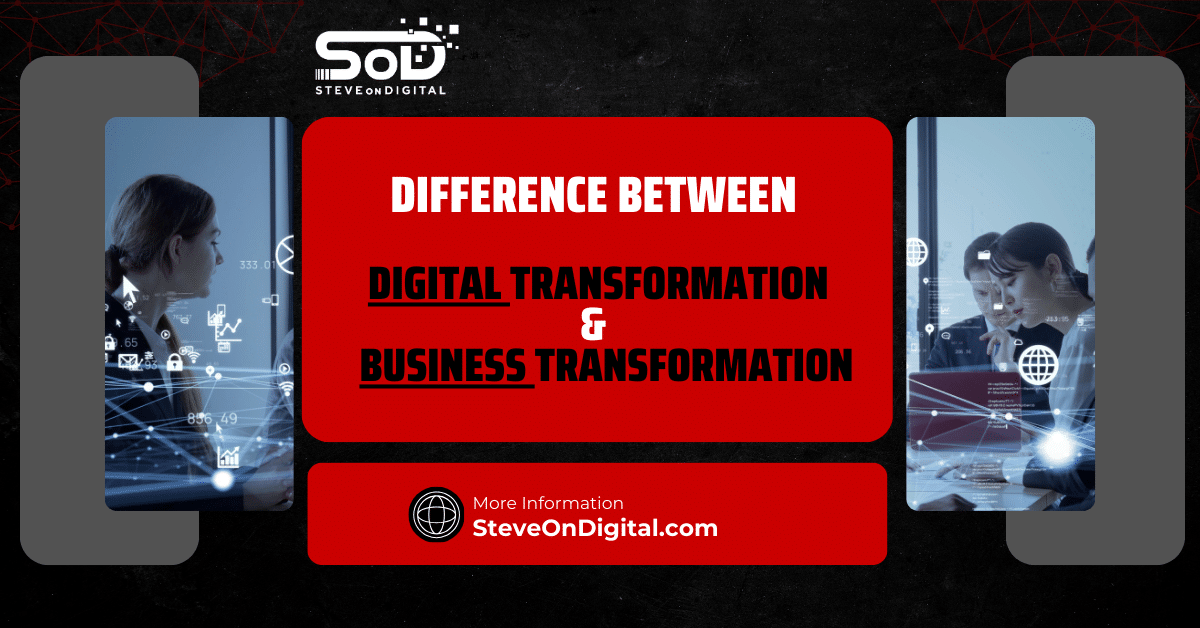Creating a digital roadmap is crucial for business success and transformation. It acts like a GPS for your business, guiding you on where you are, where you need to go, and how to get there efficiently. To achieve this, it is essential to create a digital transformation roadmap, which involves assessing the organization’s digital maturity, defining objectives, prioritizing initiatives, integrating cutting-edge digital tools, and revolutionizing business practices. Without a digital roadmap, businesses often struggle with new digital technologies, leading to wasted resources and missed opportunities.
I bring expertise in digital transformation, backed by an electrical engineering background, an MBA, and a master’s in Project Management. My goal is to help SMEs navigate the digital landscape with practical advice and insights.
Understanding Digital Transformation
Digital transformation refers to the integration of digital technologies into all areas of a business, fundamentally changing how you operate and deliver value to customers. It’s about more than just adopting new technologies; it’s about rethinking your business model and processes to stay competitive in today’s fast-paced digital world. A well-defined digital transformation roadmap is crucial in guiding the creation, execution, and importance of a strategic plan outlining the steps and milestones for integrating digital technologies into an organization’s operations.
Digital transformation is not a one-size-fits-all solution. Each business needs to tailor its digital transformation strategy to meet its unique needs and goals. This involves understanding your current digital capabilities, identifying areas for improvement, and creating a plan to implement new digital technologies and processes.
Why You Need A Digital Roadmap
A digital roadmap is essential for guiding your business through the digital transformation process. It provides a clear, step-by-step plan for implementing digital technologies and processes, ensuring that all stakeholders are aligned and working towards the same goals. Digital initiatives play a crucial role in this process by implementing new digital strategies, technologies, and roadmaps to achieve more efficient business processes, digitally innovate, and create competitive advantages. Here are some key benefits of having a digital roadmap:
Importance Of Effective Communication
A focused digital strategy helps in aligning stakeholders and communicating the vision effectively. By clearly outlining the steps and goals of the digital transformation process, you can ensure that everyone in your organization understands the plan and their role in it. This is crucial for getting buy-in from all levels of the organization and ensuring that the transformation is successful.
Viewing Digital Transformation As A Digital Transformation Journey
Digital transformation is an ongoing process rather than a one-time project. It’s important to view it as a journey that involves continuous learning, adaptation, and improvement. A digital roadmap helps you stay focused on your long-term goals and make incremental progress towards achieving them. It allows you to break down the transformation process into manageable phases and track your progress along the way. Digital transformation roadmaps serve as the pathway from strategic vision to digital transformation goals, providing a clear, focused, and measurable plan for enacting transformation strategies.
Supporting Decision-Making
Knowing the reasons behind your digital transformation aids in making informed decisions during the process. A digital roadmap provides a framework for evaluating new technologies and processes, prioritizing projects, and allocating resources. It helps you make strategic decisions that align with your overall business goals and ensure that your digital transformation efforts are focused and effective.
Assessing Your Starting Point
Before you can create a digital roadmap, you need to assess your starting point. This involves evaluating your current digital capabilities, identifying areas for improvement, and setting realistic goals for your digital transformation journey. It is also crucial to review existing digital processes to identify any gaps or inefficiencies. Here are some steps to help you get started:
Conducting A SWOT Analysis
A SWOT analysis is a useful tool to find out your business’s good points and bad points, and to see what chances and risks are outside your business. By conducting a thorough SWOT analysis, you can gain a better understanding of your current digital capabilities and identify areas where you need to improve. Here are some tips for conducting a SWOT analysis:
- Strengths: Identify your internal strengths, such as strong leadership, skilled employees, and advanced digital tools. These are your competitive advantages that you can leverage during the digital transformation process.
- Weaknesses: Identify your internal weaknesses, such as outdated technologies, lack of digital skills, and resistance to change. These are areas where you need to focus your efforts to improve.
- Opportunities: Identify external opportunities, such as new technologies, market trends, and customer demands. These are areas where you can capitalize on to drive your digital transformation efforts.
- Threats: Identify external threats, such as competition, regulatory changes, and economic instability. These are challenges that you need to address to ensure the success of your digital transformation efforts.
| Category | Description |
| Strengths | Strong leadership, skilled employees, advanced digital tools |
| Weaknesses | Outdated technologies, lack of digital skills, resistance to change |
| Opportunities | New technologies, market trends, customer demands |
| Threats | Competition, regulatory changes, economic instability |
Evaluating Current Digital Capabilities
Assessing your existing digital tools and technologies is crucial for understanding your starting point in leveraging digital technology. This involves conducting a thorough review of your current digital processes, systems, and tools. Here are some tips for evaluating your current digital capabilities:
- Inventory of Digital Tools: Create a comprehensive list of all the digital tools and technologies currently used in your business. This includes software, hardware, and digital platforms.
- Assess Digital Processes: Evaluate the efficiency and effectiveness of your current digital processes. Identify any bottlenecks, redundancies, or inefficiencies that need to be addressed.
- Digital Skills Assessment: Assess the digital skills and capabilities of your employees. Identify any skill gaps that need to be addressed through training and development.
- Customer Feedback: Gather feedback from your customers to understand their digital experience with your business. Identify any pain points or areas for improvement.
By conducting a thorough assessment of your current digital capabilities, you can gain a better understanding of your starting point and identify areas for improvement. This will help you create a digital roadmap that is tailored to your unique needs and goals, and ensure the success of your digital transformation efforts.
Identifying Your Highest Value Interaction
The first step in creating a digital roadmap is identifying your highest value interaction. This is the process or interaction in your business that generates the most revenue. Focusing on this ensures that your digital transformation efforts have the maximum impact. Implementing an innovative digital strategy can further optimize these high-value interactions by leveraging new digital initiatives and technologies.
Understanding Quote-To-Cash Processes
The quote-to-cash process is the sequence of steps from providing a quote to receiving payment. This process is crucial because it directly affects your cash flow. Identifying and optimizing this process can significantly boost your business’s profitability. Here’s how you can approach it:
- Map the Process: Outline each step from the initial quote to receiving payment.
- Identify Bottlenecks: Look for delays or inefficiencies in the process.
- Implement Improvements: Use digital tools to streamline and automate steps wherever possible.
Engaging With Your Team
Involving your employees in the digital transformation process is essential. They can provide valuable insights and help ensure the success of your initiatives. It is crucial to drive change implementation and digital adoption across the entire organization, focusing on people-centric and cultural changes.
Conducting Interviews And Workshops
One effective way to engage with your team is by conducting interviews and workshops. These sessions allow you to gather insights about current processes and identify areas for improvement. Here are some tips:
- Interviews: Speak with employees at all levels to understand their daily challenges and suggestions.
- Workshops: Organize collaborative sessions where employees can brainstorm and discuss potential improvements.
Addressing Employee Concerns
Change can be challenging, and employees may have concerns about digital transformation. Addressing these concerns is crucial for a smooth transition. Here are some strategies:
- Open Communication: Keep employees informed about the transformation process and how it will benefit them.
- Support and Training: Provide necessary training and support to help employees adapt to new technologies and processes.
Mapping Out Your Processes
Once you’ve gathered insights from your team, the next step is to map out your key business processes. This helps you understand the current state of your processes and identify areas for improvement. Embracing new technology can significantly enhance these processes, driving digital transformation and meeting the demands of modern consumers.
User Experience (UX) Mapping
Understanding the user journey is critical for improving customer satisfaction. UX mapping involves analyzing how users interact with your business and identifying any friction points. Here’s how you can do it:
- User Testing: Conduct tests with actual users to observe their interactions.
- Journey Mapping: Create detailed maps of the user journey, highlighting pain points and opportunities for improvement.
Customer Experience (CX) Mapping
Mapping customer interactions helps improve overall customer satisfaction. This involves looking at every touchpoint a customer has with your business. Here are some steps:
- Touchpoint Analysis: Identify all the points where customers interact with your business.
- Feedback Collection: Gather feedback from customers to understand their experiences and expectations.
Employee Experience (EX) Mapping
Optimizing the employee experience can enhance productivity and job satisfaction. EX mapping involves understanding the workflows and processes from the employees’ perspective. Here’s how:
- Workflow Analysis: Map out the workflows for key processes and identify inefficiencies.
- Employee Feedback: Collect feedback from employees about their experiences and suggestions for improvements.
Creating Your Digital Transformation Plan
With a clear understanding of your current processes, you can now develop a comprehensive digital transformation plan. This plan will guide your efforts and ensure that you achieve your digital transformation goals. Implementing digital strategies empowers companies to protect themselves from culture shifts and digital threats, allowing them to identify and prepare for potential threats from afar.
Prioritizing Projects In Your Digital Transformation Strategy
Not all digital strategies can be implemented at once. Prioritizing projects ensures that you focus on the most critical initiatives first. Here are some tips for prioritizing:
- Impact Analysis: Evaluate the potential impact of each project on your business goals.
- Resource Allocation: Consider the resources required for each project and allocate them accordingly.
| Project Name | Impact Score (1-10) | Resource Requirement (1-10) | Priority Level |
| Automate Customer Service | 9 | 7 | High |
| Upgrade CRM System | 8 | 5 | Medium |
| Implement AI Analytics | 7 | 8 | Medium |
| Improve Website UX | 6 | 4 | Low |
Setting Timelines And Phases
Establishing clear timelines and phases for your projects helps keep the transformation process on track. Here’s how you can do it:
- Project Phases: Break down projects into manageable phases.
- Timeline Creation: Create a realistic timeline for each phase, considering dependencies and potential delays.
Incorporating Training And Change Management
Ensuring your team is prepared for the upcoming changes is critical for a successful transformation. Here are some steps:
- Training Programs: Develop training programs to help employees learn new skills and technologies.
- Change Management: Implement change management strategies to support employees through the transition.
Measuring Success
To know if my digital transformation efforts are working, I need to establish clear metrics. These metrics help track progress and identify areas for improvement.
Quantitative Measurements
Quantitative measurements involve defining key performance indicators (KPIs) and other numerical metrics. Here are some essential ones to consider:
- Revenue Growth: Track the increase in revenue post-transformation.
- Cost Reduction: Measure savings from improved efficiency.
- Digital Adoption Rates: Monitor how quickly and effectively employees are using new digital tools.
- Operational Efficiency: Assess improvements in process efficiency, such as reduced time to complete tasks.
| KPI | Description | Measurement Metric |
| Revenue Growth | Track the increase in revenue post-transformation | % Increase in Revenue |
| Cost Reduction | Measure savings from improved efficiency | % Decrease in Operational Costs |
| Digital Adoption Rates | Monitor how quickly and effectively employees are using new digital tools | % Adoption Rate |
| Operational Efficiency | Assess improvements in process efficiency | Time to Complete Tasks |
Using these KPIs, I can quantify the impact of the digital transformation and adjust strategies as needed.
Qualitative Measurements
Quantitative data is crucial, but qualitative feedback provides deeper insights. Gathering feedback from customers and employees helps understand their experiences and perceptions.
- Customer Satisfaction Surveys: Regularly ask customers about their experience with new digital processes.
- Employee Feedback: Conduct internal surveys to gauge employee satisfaction and identify pain points.
- Focus Groups: Organize sessions with both customers and employees to get detailed feedback on specific aspects of the transformation.
Combining qualitative and quantitative data gives a complete picture of the transformation’s success.
Gaining Stakeholder Buy-In
For a successful digital transformation, it’s vital to secure support from management and stakeholders. Their buy-in can significantly influence the transformation’s outcome.
Presenting The Plan To Management
Effective communication is key when presenting the digital transformation plan to upper management. Here’s how I approach it:
- Clear Objectives: Outline the goals and benefits of the transformation.
- Detailed Roadmap: Provide a step-by-step plan, highlighting key milestones and timelines.
- Risk Assessment: Address potential risks and how they will be mitigated.
- ROI Projections: Show projected returns on investment, backed by data.
A well-prepared presentation can convince management of the plan’s viability and benefits.
Building Consensus And Support
Building consensus across the organization ensures everyone is on the same page. Here are some methods to gain support:
- Stakeholder Meetings: Hold regular meetings with key stakeholders to discuss progress and address concerns.
- Communication Channels: Use internal communication platforms to keep everyone informed.
- Involvement: Involve employees in the planning and implementation phases to increase their engagement and commitment.
Building a collaborative environment fosters a sense of ownership and support for the digital transformation.
Launching Your Digital Roadmap
Once the plan is ready and stakeholders are on board, it’s time to officially kick off the digital transformation journey.
Communicating The Launch
Announcing the start of the transformation effectively is crucial. Here are some strategies:
- Company-Wide Announcements: Use emails, newsletters, and meetings to inform everyone about the launch.
- Visual Aids: Create infographics and videos to explain the roadmap and its benefits.
- Launch Events: Host events or webinars to celebrate the kickoff and generate excitement.
| Strategy | Key Elements | Purpose |
| Company-Wide Announcements | Emails, newsletters, meetings | Informing all employees |
| Visual Aids | Infographics, videos | Explaining the roadmap and benefits |
| Launch Events | Events, webinars | Generating excitement |
Clear and enthusiastic communication helps set the tone for the transformation journey.
Setting Realistic Expectations
It’s important to help the team understand both the challenges and benefits of the transformation. Here’s how I do it:
- Transparent Communication: Be honest about potential challenges and the time required for changes.
- Milestone Celebrations: Celebrate small wins along the way to keep morale high.
- Support Systems: Provide resources and support to help employees adapt to new processes.
Setting realistic expectations ensures the team remains motivated and committed throughout the transformation.
Maintaining Momentum
Ensuring continuous progress and adaptation is essential for a successful digital transformation.
Continuous Improvement
Ongoing evaluation and improvement of digital processes are crucial. Here are some techniques:
- Regular Reviews: Schedule periodic reviews to assess progress and identify areas for improvement.
- Feedback Loops: Create systems for continuous feedback from customers and employees.
- Agile Methodology: Use agile practices to make iterative improvements and adapt quickly to changes.
| Technique | Description |
| Regular Reviews | Schedule periodic reviews to assess progress |
| Feedback Loops | Create systems for continuous feedback from customers and employees |
| Agile Methodology | Use agile practices to make iterative improvements |
Continuous improvement helps maintain the momentum of the digital transformation.
Adapting To New Technologies
Staying updated with emerging technologies and integrating them into the roadmap is vital. Here’s how I approach this:
- Technology Watch: Regularly monitor technological trends and advancements.
- Pilot Programs: Test new technologies on a small scale before full implementation.
- Training Programs: Provide ongoing training to ensure the team is proficient with new tools.
Adapting to new technologies ensures that digital transformation remains relevant and effective.
Final Thoughts
Creating a digital roadmap is a comprehensive process that involves careful planning, execution, and continuous improvement. By following the steps outlined in this guide, I can ensure a successful digital transformation that enhances my business’s efficiency, competitiveness, and overall success.




